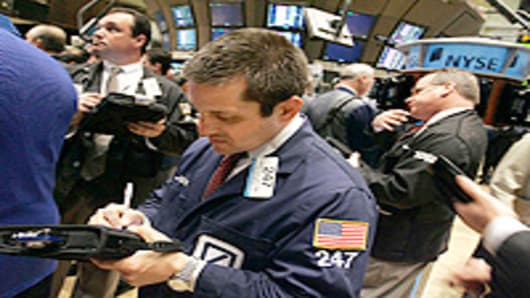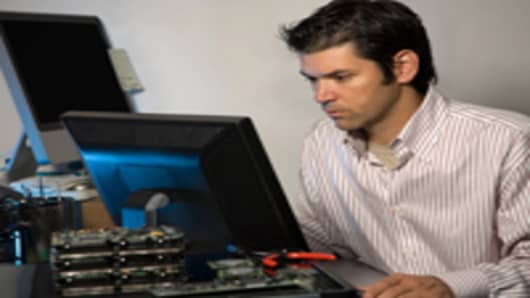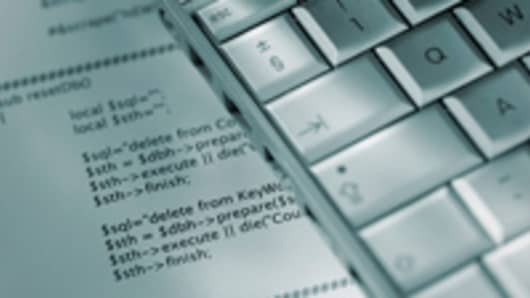Stock trading today is both easier and more complicated than ever before. The easy part: just about anyone with a computer and an online brokerage account can buy and sell stocks. The complicated part: those transactions are part of an extensive electronic web of computers, exchanges, and trading systems.
How It All Happens
Let's start with a simple trade: Greg Thompson, a Scottrade customer, is sitting in his office in St. Louis and puts in a market "buy" order (an order to buy at whatever the best price is) for 100 shares of IBM.
He pushes the button, and the order is executed. A second or two later, he gets a confirmation back: he has bought 100 shares of IBM at the current price, $128.56.
"I enjoy the challenge, it's a lot of fun, and sometimes I can make some money," says Thompson.
But wait: what just happened here? Where did this order go? How was it executed? Who sold the stock to him?
Scottrade is a discount broker. It buys and sells shares using market makers like Knight Capital, UBS, and Citigroup. To get to those market makers, Scottrade and all other brokers have an electronic order routing system.
How do they and their competitors decide who to send the order to? The criteria include speed, price, and quality of the service.
Discount brokers do receive payments from market makers for order flow, though brokers like Scottrade say it is not a criteria for deciding where orders are sent.
Let's say Scottrade's order routing system determines that Knight Capital has the best combination of payment, speed and price and routes the order to them. Knight sells Scottrade 100 shares immediately. Mr. Thompson's order is now filled—he owns 100 shares of IBM, at $128.56.
But that's not the end of the story. Where did Knight get the 100 shares from?
In most cases, Knight and other market makers internalize the order—they match off the order to buy 100 shares with another order to sell 100 shares that is already in their system. "The vast majority of the time, we buy and sell from our own inventory. In some cases, we go out to some other venue to get those shares," says Jamil Nazarali, Senior Managing Director, Global Head of the Electronic Trading Group at Knight.
Among those other venues or choices: They can send the order out to an exchange or a dark pool (but this will cost them money), or they could also stay short the stock and hope they can buy it back in a short time at a lower price.
Only the last choice will likely make them money.
Here's how: Let's say they hold on to the stock for a few seconds and are able to buy it at $128.55. They sold it to Thompson for $128.56, so Knight will make a profit of $1.00 (100 shares times the one penny-per-share profit).
But Knight will also pay a rebate (payment for order flow) to Scottrade and other discount brokers. These payments vary, but are typically a tenth of a cent per share. Let's say in this case Knight pays a rebate of $0.10 to Scottrade for the order, leaving a total profit of $0.90 ($1.00 - $0.10).
Doesn't sound like much (remember, most of the trades don't make money) but do this millions of times each day and you can make money. But you need huge volume.
Pump Up the Volume: Connecting Buyers and Sellers
Indeed, these types of trades do happen millions of times a day: retail customers like Thompson interact with online brokers (AmeriTrade, Schwab, ETrade, Scottrade, etc.) who route orders to market makers, who in turn match orders against their own supply or interact with exchanges (NYSE, Arca, NASDAQ, BATS, Direct Edge).
Now let's see how this order of Thompson's might interact with other players.
Outside Philadelphia, Gus Sauter walks one of the trading floors of Vanguard, one of the largest mutual fund companies in the United States. Sauter is Vanguard's Chief Investment Officer and this particular trading desk trades more than 10 million shares of stock a day, including many shares of IBM.
The goal of Sauter and his trading desk is to get the lowest execution cost, and he has several choices when he has to buy or sell stocks like IBM. He can execute a particularly large order manually by directing all or parts of it to specific trading venues. Or, he can bundle orders to buy and sell many different stocks into a "basket" that will be executed as a single computer program.
He can also choose to use an an algorithm and a smart order routing system, which will likely chop up an order to buy or sell a specific stock (like IBM) into small pieces (100 orders of 100 shares each, for example), and will then direct those orders to whatever venue offers the best combination of speed and price.
So it's likely that part of any order to buy or sell IBM will end up in different locations: at a market maker like Knight Capital or UBS , exchanges like the NYSE, NASDAQ, or BATS, or dark pools like Liquidnet. "We might rifle through all of those trading venues in a matter of a fraction of a second and get our trades executed that way," says Sauter.
Clearly, Sauter's trade is considerably more complicated than Thompson buying IBM at Scottrade.
Sauter may include specific instructions on how the order is to be executed. For example, some mutual fund and pension fund managers want to make sure their trades are executed at the Volume Weighted Average Price (VWAP), which is the dollar value of all the shares traded in that stock divided by the volume. This is a measure to ensure that price execution is at least as good as the average.
Sauter says he has an even higher standard for his orders. He wants to make sure that the stock is bought or sold at the price he or his fund managers want to buy or sell it at, not the market price. If a Vanguard fund manager wants to sell IBM at $128.60, for example, he may want his broker to make sure he sells at that price, and not, say, at $128.58 (this is called "implementation shortfall").
Other factors beside speed and price may also influence the decision of asset managers. Some may want to send order flow to a specific firm in exchange for services—analyst research, trader commentary, access to conferences and meetings. In exchange, the firm may provide execution to an asset manager at very low cost.
"There are just so many different choices we have and we look for the one that's going to minimize the transaction costs that we're going to incur," Sauter says.
Third Player: High-Frequency Trading
A hundred miles away, in the middle of New Jersey, Manoj Narang is sitting at his desk at Tradeworx, a high-frequency trading company.
Narang trades using statistical arbitrage, where traders are short one security and long another, based on historical performance.
For example, IBM historically trades in a certain relationship with the S&P 500. When it trades above that relationship, Narang's computers may put in large orders to sell IBM and buy the S&P (all in a fraction of a second) assuming the relationship may revert to its historic mean.
Narang says they trade 50 to 100 million shares of stock a day, including many trades in IBM, but the day I am there is a relatively slow one in August. It is 3pm ET, an hour before the market closes, and Narang's firm has traded 21 million shares, for a net profit of $7,000.
Narang and other high-frequency traders execute their trades through direct access. The computers are linked to servers very close to those of the major exchanges. Why? Because the pricing inefficiencies last for only a fraction of a second, so speed is paramount.
"When you have opportunities as small as a tenth of a cent per share, they tend to come and go very quickly. Maximum speed to the exchanges is desirable, so we put our servers physically at the enchants," says Narang.
Bottom Line: Technology, Liquidity, Complexity
So what is happening here? Three customers—Thompson, who wants to buy 100 shares of IBM, Sauter, a mutual fund manager who will be buying or selling tens of thousands of shares or more of IBM, and Narang, a high frequency trader who will also be buying and selling thousands (perhaps millions) of shares of IBM—are all interacting in different spaces: in the computers of market makers who match off the orders, on exchanges, and in alternative trading systems like dark pools.
All three of these orders could interact with each other. All three of these customers, in their own way, are adding liquidity—but there are a lot more places for them to trade.
How did things get so complicated? You can blame it on the relentless march of technology and a decision by the SEC to encourage competition among exchanges.





